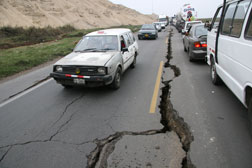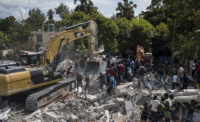 C.J. Schexnayder Homes made with heavy adobe brick suffered most. |
PISCO, Peru–It took just two minutes to reduce the town of Pisco, Peru to rubble.
On Aug 15 a massive magnitude 8.0 earthquake struck just off the coast of Southern Peru and this bucolic fishing town was the closest community to the epicenter. Officials estimate that more than 70 percent has been destroyed. The quake also punished Chancha and Ica, two other towns, and delivered a heavy blow to the regional road network, a vital part of the economy.
After several frantic days of searching the rubble for survivors, rescue workers turned to the grim task of recovering bodies. And then, President Alan Garcia called in the engineers.
"We are moving past the first phase of the disaster response where we must bury the dead, transfer the injured and assure that water and aid is available to the survivors," says Peruvian President Alan Garcia. "Although there is still work to be done, we have to start now on the next phase where we remove the debris and facilitate the reconstruction of these cities."
Garcia also asked that the Peruvian Chamber of Engineers to provide a list of firms that could provide volunteer engineers to help with the recovery and rebuilding effort.
The President of the Lima College of Engineers, Jorge Alva Hurtado, says that his organization has had engineers in the disaster zone since the day the earthquake struck and that others are prepared to come when needed.
"There are thousands of my colleagues ready to be called to help with the effort but it is necessary to perform some analysis of the zone," he told El Comercio, a newspaper.
The preliminary assessment is sobering. In addition to Pisco, Chancha and Ica, several smaller communities were almost completely destroyed. The death toll of the disaster has topped 550 but is expected to climb much higher as the efforts to recover bodies buried in the rubble begins in earnest.
In the city of Pisco, which is home to more than 120,000, officials estimate more than 70 percent of the city is destroyed. Many of the structures that have remained standing are marked with a chalk 'X' on the door indicating they are unsafe to enter, particularly as the area continues to suffer aftershocks as strong as magnitude 5.0 or more.
The plight of the survivors is harsh. There is no temporary housing–most residents are living in makeshift tents or simply in the streets–and food and fresh water are being brought in by any method possible. Most of the affected area still lacks electricity.
While donor nations and relief agencies have pledged a total of $40 million in aid for those affected by the disaster, the Peruvian government has already started assembling funding and resources for the rebuilding effort. The government created an emergency account of more than $31 million for reconstruction effort and more than $5 million in funds have been freed for various agencies involved in the immediate aid efforts.
Private sources also are mobilizing. The president of the Banco de la Nación is creating a $95-million fund for the reconstruction of the affected zones. The head of the bank, Enrique Cornejo, said that the reconstruction period is an ideal time to inform residents of the need to construct more durable homes. One government program will provide 8,000 workers to help with the rebuilding effort. Although the effort is only slated for 30 days, officials at the agency in charge say they will extend the effort as long as is necessary.
How much poor quality building materials and lax standards abetted the disaster can't be known yet.
The most dramatic collapsed structure was Pisco's 128-year-old the San Clemente church, in the main square of town. Dozens died during a memorial service when the adobe walls fell in. Worshippers standing in the concrete atrium, rebuilt in 1974, survived.
Adobe bricks are the material-of-choice in poor areas but the bricks are heavy and next to useless under the stress of a major quake. In poorer areas of the region where adobe bricks were the main material almost no structure survived.
The earthquake took a toll on the concrete buildings in Pisco as well. Many of these collapsed as well and only a handful remain intact enough for use. The walls of the emergency and surgical rooms of the city's main hospital collapsed and the bottom two floors of one of the city's largest hotels, Hotel Embassy, simply disintegrated.
The use of inexpensive adobe tends to be widespread but adobe has two key deficiencies in the face of an earthquake, says Mark Ellis, a structural engineer specializing in earthquake risk for Thornton Tomasetti PC, the New York City–based engineering firm. "First, it's heavy and in a quake weight works against you," he says. "Second,...


Post a comment to this article
Report Abusive Comment